The demand of electricity in our day to day life is increasing but the terrible fact is that the electricity production is equally decreasing. Scientists are gathering up to explore and conceive new ideas for electricity production and conservation. In current scenario we are trapping the renewable solar energy with the help of solar panels. The production of electricity is an ongoing process but the need for effective utilization and conservation is highly valid. In this paper the implementation of solar panels in indoor application with the consideration of effective utilization of the waste energy from lighting sources in household areas are taken in to account. The thought of energy management should be started off from the base i.e.: from our homes has taken this project in to a higher level. The results indicate an overcome of the drawbacks in the lightings in which much of its energy is wasted in IR and UV, rather than using as visible light. The outcome of our research idea is practically verified the efficiency table and block diagram has been plotted.
Keywords |
| Solar energy, Solar panel, Battery unit, Inverters, energy efficient lightings, etc., |
INTRODUCTION |
| Solar energy is one of the largest renewable source available in our universe. So how much power we can get from the
sun is one thing, but how much power is available from the sun is another. At any moment, the sun emits about 3.86 x
1026 watts of energy. So add 24 zeros to the end of that number, and you’ll get an idea of how unimaginably large an
amount of energy that is! Most of that energy goes off into space, but about 1.74 x 1017 watts strikes the earth. If there
are no clouds in the way, then one square meter of the earth will receive about one kilowatt of that energy. And best of
all, solar power is extremely clean, with zero greenhouse gas emissions. |
| Power harvested from the Sun is pouring into electricity grids by the gig watt,butthe biggest problem with solar power
is the most obvious one: The sun doesn't shine all the time. At nighttime or on cloudy days, power plants simply can't
access the sun's energy. This makes solar power expensive, since the power plants can't run 24/7. A cloud floats
overhead and the plant is suddenly at an energy standstill, producing nothing. It also makes solar-generated power
unavailable at times -- like at night, when power demand is greatest. |
| The solution is a simple one: Store the sun's energy so you can use it when the sun's not available. Unfortunately,
implementing that solution has been extremely problematic.But our venture has proven the use of solar panels in indoor
with the utilization of room temperature during daylight and also that of the radiant light energy produced by the
lightings during night times in our household.ie: 24(hours)/7(days) power production using solar panels.Lighting
accounts for about five to ten precent of total energy use, or $50 to $150 per year in the typical home. The heat energy
produced by these lightings could be collected and used to provide electricity to other home appliances during peak
hours .Thus here we are utilizing the disadvantage of lightings in our household to add on to the electricity collected
through renewable sources to provide for our home appliances. |
| In this article, we'll find out using our simple idea, how it's possible to efficiently store the power in sunshine and the
heat energy of lightings so that we can access it when the sun sets. It is said that “The simplest ideas are often the most
effective”. |
LITERATURE SURVEY |
| [1] Vijay Devabhaktuniet al. explains the global demand for energy is currently growing beyond the limits of
installable generation capacity. To meet future energy demands efficiently, energy security and reliability must be
improved and alternative energy sources must be investigated aggressively. An effective energy solution should be able
to address long-term issues by utilizing alternative and renewable energy sources. Of the many available renewable
sources of energy, solar energy is clearly a promising option as it is extensively available. Solar power, especially as it
reaches more competitive levels with other energy sources in terms of cost, may serve to sustain the lives of millions of
underprivileged people in developing countries. Furthermore, solar energy devices can benefit the environment and
economy of developing countries. More over this paper illustrates the need for the utilization of alternative energy
sources, evaluates the global scenario of installed generation systems, reviews technologies underlying various solar
powered devices, and discusses several applications and challenges in this area. In addition, this paper addresses the
costs of deployment, maintenance, and operation, as well as economic policies that promote installation of solar energy
systems. |
| [2] Mehdi Hajian, describes the Solar Energy (SE) is a key resource for the future of the world. The utilization of SE
could cover a significant part of the energy demand in the countries. Using of SE in its various aspects, therefore, is
very attractive in this part of the world. A comprehensive review of the different designs, details of construction of the
wide diversity of practically designs of SE systems reported previously is presented. Therefore, in this review paper, an
attempt has been taken to summarize the past and current research in the field of SE technology. The main objectives of
this research are to present the current status and future aspects of SE in the world by comprehensively reviewing
various SE related studies conducted up to date and to highlight some corresponding available sustainable energy
methods towards establishing energy policies. |
| [3] VanyaZhivkovarepresents the amount of solar radiation per unit time on unit area. Solar energy is used to obtain
thermal energy through solar, and electrical energy through exist for solar energy: passive and active. The utilization of
solar energy is essential for the development of human civilization. |
| [4] AmelDhahriet al. presents an overview of the main characteristics of a novel kind of solar thermal application
called solar chimney power plant. It is a technology of electric power generation using solar energy by employing basic
physics that when air is heated it rises. The created updraft can be used to turn a turbine placed at an appropriate
position within a tall chimney to generate electricity. The paper discusses the principles and characteristics of such a
system, its requirements, its construction and its operation. It also focuses on actual research and development of solar
chimney projects. |
| [5] Naresh Kumar Malik et al. demonstrates the pphotovoltaic cells provide an additional method of acquiring energy,
converting sunlight directly into electricity through the use of semiconductors. Effective photovoltaic implementation is
reviewed, focusing on semiconductor properties and overall photovoltaic system configuration |
EXISTING SYSTEM |
| Using solar panel to produce electricity from solar energy:The solar panel consist of solar cells that are made up of
silicon.Each solar cell is divided in individual photovoltaic segments, or “sub-cells” that are electrically connected in
series by laser etching and lift-off masking technology.Light striking a silicon semiconductor causes electrons to flow,
creating electricity. Solar power generating systems take advantage of this property to convert sunlight directly into
electrical energy.Solar panels ( also called “solar modules”) produce direct current (DC), which goes through a power
inverter to become alternating current (AC) electricity that we can use in the home or office, like that supplied by a
utility power company. |
| Incandescent lamps, commonly called "light bulbs," give off 90% of their energy as heat, and only 10% as light. But
nowadays energy efficient lightings ie: compact florescent lights are mainly used.The disadvantage of this light is that
much of its energy is wasted in the infrared or the ultraviolet, rather than used as visible light implying that most of the
energy goes into heat. |
| Now we are proposing an idea utilising the disadvantage of florescent lamps along with the existing system. The idea is
put forward considering the cases of limited solar energy supply during winter season and during night times.Here we
are harvesting the room temperature during day time and the heat energy emitted by the light during night time which
are inturn stored in a battery with the help of solar panels.The materials used for the proposed system are cheaper,
highly efficient as well as durable. |
| For an indoor use, we have taken a solar panel of 12V,100 W of size 2 x 3. The solar cells are warranted 5 years, and
have a lifetime around 10 years in normal conditions (neutral atmosphere, not salty, nor corrosive). These solar panels
works efficiently at a climatic category from -40 °C to +70 °C. They are then connected to a storage device ie: battery.
(battery info: EXIDE 6-EL tubular battery,with 28AH capacity). The batteries were so selected with its characteristics
features being low maintenance, lasts 3 times longer than ordinary batteries and they come up with a warranty of 36
months. Storage batteries provide the back up power during no sun shine period by storing the excess power or some
portion of power from the solar arrays. |
PROPOSED SYSTEM |
| Incandescent lamps, commonly called "light bulbs," give off 90% of their energy as heat, and only 10% as light (shown
in Fig. 3). But nowadays energy efficient lightings i.e.: compact fluorescent lights are mainly used. The disadvantage of
this light is that much of its energy is wasted in the infrared or the ultraviolet, rather than used as visible light implying
that most of the energy goes into heat.Now we are proposing an idea utilizing the disadvantage of fluorescent lamps
along with the existing system. The idea is put forward considering the cases of limited solar energy supply during
winter season and during night times. Here we are harvesting the room temperature during day time and the heat energy
emitted by the light during night time which are in turn stored in a battery with the help of solar panels. |
| The materials used for the proposed system are cheaper, highly efficient as well as durable. |
| For an indoor use, we have taken a solar panel of 12V, 100 W of size 2 x 3 (shown in Fig.2). The solar cells are
warranted 5 years, and have a lifetime around 10 years in normal conditions (neutral atmosphere, not salty, nor
corrosive). These solar panels works efficiently at a climatic category from -40 °C to +70 °C. They are then connected
to a storage device i.e.: battery. (Battery info: EXIDE 6-EL tubular battery, with 28AH capacity). The batteries were so
selected with its characteristics features being low maintenance, lasts 3 times longer than ordinary batteries and they come up with a warranty of 36 months. Storage batteries provide the backup power during no sun shine period by
storing the excess power or some portion of power from the solar arrays. |
EXPERIMENTAL SETUP |
| There are three categories of indoor lighting: fluorescent, incandescent, and daylight. Our predominant focus will be on
fluorescent lighting, due to its popular use in home, business, and warehouses. Care is taken to ensure that there is no
stray light affecting the measurements. Here a solar panel is placed in a room. We kept the solar panel at a distance of 6
feet from the common fluorescent lamp in a horizontal position (parallel to the light source) so as to increase the
reflection area. The initial charge in the battery was noted as 10.33 V. The light was switched ON. Using a multimeter
the voltage produced by the solar panel alone was noted down. Voltage produced in the solar panel has been noted to
be 7.14 V. it was then connected to the battery. (The time to be noted as 5:00 pm). After about 5 hours the voltage
stored in the battery was noted to be 12.36V. An approximate increase of 2 V has been identified. |
| Similarly another setup was made to note down the voltage produced by the battery with the variation in light intensity,
distance of solar panel from the light and capacity of battery. Here we used a fluorescent lighting of 26W (lesser than
initial case), and kept the solar panel at a distance of 6 feet from the light (more than the initial case). The voltage from
the solar panel was noted to be 5.36V. It was then connected to a 60AH battery with an initial charge of 11.32 V. After
a time of 5 hours the voltage in the battery was noted to be 12.93V. A rise of 1V was noted. |
| The Picture (Fig. 4& Fig. 5) indicates that high initial cost is more than offset (counter balance) by the savings in
energy. I.e.: more expensive to buy, but cheaper to own because of their much lower operating cost..!! The cell
efficiency which is defined as the ratio of the solar cell peak output power divided by the incident power on the solar
cell is dependent on the lighting source. |
| The DC voltage delivered under lighting increases with the number of sub-cells i.e.: when solar panels are
connected in series output voltage produced increases. It is also seen that the output voltage increases with increase in
light intensity.ie: With the variation in illumination level of the light output voltage is also varying (but less).It has to be
noted that while comparing the output voltage produced from outdoor solar panels and indoor solar panels an efficiency
ratio of 3:1 can be derived. As much as we can say that this project has provided a simple idea in increasing the
efficiency as well as usage of solar energy in day time and during night time. |
CONCLUSION |
| From our proposed idea of producing electricity by solar panels exposed to fluorescent lightings will definitely play a
vital role in electricity conservation. As the proverb saying ”Small drops can produce a mighty ocean” , by
implementing this idea if each and every house start to harvest their own small quantity of electricity which will
ultimately lead to decreased consumption rate from EB. These solar cells can supply power to low consumption
electronic devices, for the following currents: - in micro amps full-time or in milliamps part-time under low
illumination (indoor light). Some of these include solar powered lights work very effectively as patio and walkway
lights, security lights, and to accomplish different landscape lighting effects in the garden. An efficiency of indoor
application of solar panels in terms of the outdoor application of solar panels could be written in the ratio of 3:1. |
ACKNOWLEDGEMENT |
| This project was successfully completed by the supervision of Ms C.Hemalatha, Assistant Professor/EEE/Gnanamani
College of Technology,Namakkal, TN. |
| |
Tables at a glance |
 |
| Table 1 |
|
| |
Figures at a glance |
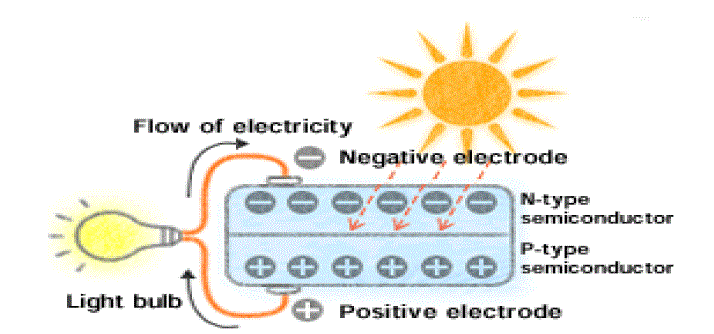 |
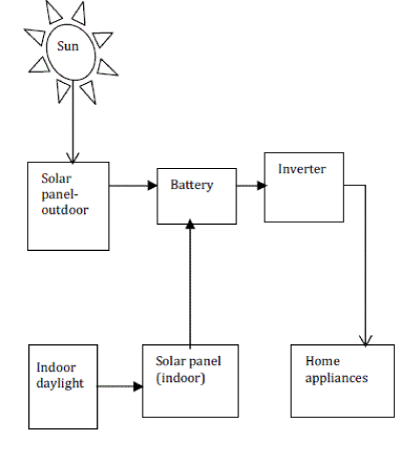 |
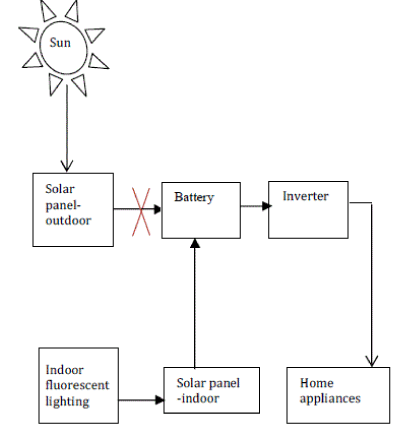 |
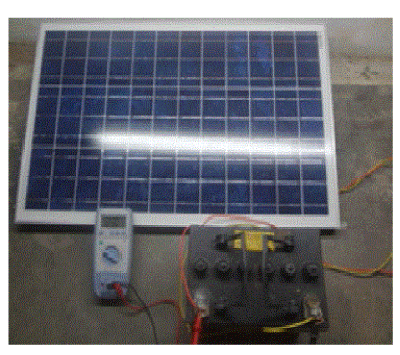 |
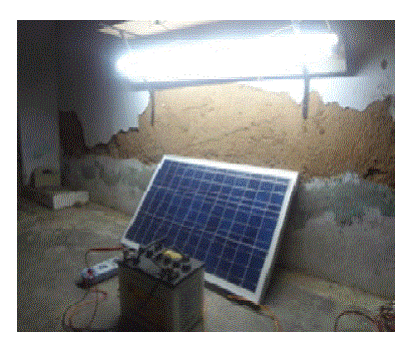 |
| Figure 1 |
Figure 2 |
Figure 3 |
Figure 4 |
Figure 5 |
|
| |
References |
- Vijay Devabhaktuni, MansoorAlam, SomaShekaraSreenadhReddyDepuru, Robert C.GreenII, DouglasNims, CraigNear, âÃâ¬ÃÅSolar energy: Trendsand enabling technologies,âÃâ¬Ã Renewable and Sustainable Energy Reviews 19 (2013) 555âÃâ¬Ãâ564.
- Mehdi Hajian, âÃâ¬ÃÅVaroius Aspects of Solar Energy Utilization: Review,âÃâ¬Ã International Journal of Advanced Science and Technology Vol.58,(2013), pp.41-50, 2013
- VanyaZhivkova, âÃâ¬ÃÅCurrent Trends in the use of Solar Energy,âÃâ¬Ã International Journal for Quality Research 7(2) 279âÃâ¬Ãâ286 ISSN 1800-6450, pp.279-286, February 2013.
- AmelDhahri, Ahmed Omri âÃâ¬ÃÅA Review of solar Chimney Power Generation Technology,âÃâ¬ÃÂInternational Journal of Engineering and AdvancedTechnology (IJEAT) ISSN: 2249 âÃâ¬Ãâ 8958, Volume-2, Issue-3, pp.1-17, February 2013.
- Naresh Kumar Malik, Jasvir Singh, Rajiv Kumar, NeelamRathi, âÃâ¬ÃÅ A Review on Solar PV Cell,âÃâ¬Ã International Journal of Innovative Technology and Exploring Engineering (IJITEE) ISSN: 2278-3075, Volume-3, Issue-1, June 2013
|